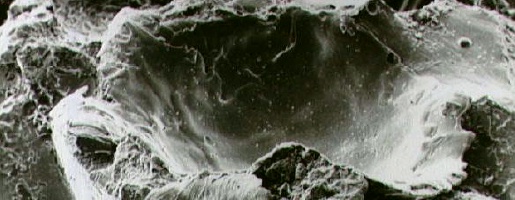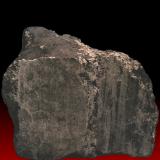 |
|
|
A
highly magnified image of an impact crater in lunar soil, caused by
a micrometeoroid.
|
|
| METEORITES | |
| Meteoroids are small rocks in orbit around the Sun. Far smaller than asteroids, they make their presence known to us dramatically when they enter Earth's atmosphere and burn up. As the meteoroid burns it creates a bright trail across the sky - at this point it is called a meteor. If, and only if, it hits the ground is it termed a meteorite. Most meteoroids are burnt to destruction at altitudes between 80 and 110 kilometres. | |
| Many meteoroids are small grains of rock - these produce a very short and quick trail in the night sky, often lasting only a second or two. Larger meteoroids can produce spectacular fireballs, often resulting in an impact. Exceptionally small meteoroids are nothing more than dust particles. As the Earth travels in its orbit, it picks up nearly 80,000 tons of meteoroid material per year. Some of this dust has been collected by high-flying aircraft. | |
| Of course, Earth is not the only target. Meteoroids also impact other bodies - the moons of Jupiter are being hit frequently, to such an extent that the impact ejecta helps maintain the ring system. | |
 One of the smallest lunar craters - a micrometeorite crater in lunar soil at 4850 times actual size. |
|
| Origins | |
| Many meteoroids originate as fragments of asteroids and appear to be unaltered since the formation of the Solar System. The very small grains are thought to be inter-stellar matter that has fallen under the influence of the Sun's gravity. | |
| There are a few meteorite samples that do not match the rest of the population. Some match exactly the geology of Mars, and trapped air inside the meteorite also matches exactly the Martian atmosphere as sampled by the two Viking Landers. | |
 |
|
| Other meteorites match the geology of the rock samples brought back from the Moon by the Apollo astronauts. In the case of the Martian and lunar meteorites, it seems likely that impacts on the surface of Mars and the Moon were sufficiently strong to blast rock fragments into space. These fragments would orbit the Sun, but in an Earth-crossing orbit. Eventually, impact with Earth occurred. | |
| Apart from Earth, the Moon, and Mars, there is only one other Solar System body from which we believe we have samples. That body is the asteroid . The composition of Vesta's surface has been determined by analysing the sunlight it reflects. This composition, which is unique amongst the asteroids, has also been found in a class of meteorites called eucrites, some of which have landed on Earth this century. | |
 Eucrite meteorites exhibit similar chemical composition to the asteroid Vesta. |
|
| Composition | |
| In general meteorites are classified into three groups - stony, stony iron, and iron. Stony meteorites are the most common found on Earth, the most common in this group being the chondrites. Chondrites appear to be as old as the Solar System itself. Stony meteorites represent over 85% of all meteorites found. | |
| Chondrites have a varied geology, and it has been suggested that these variations represent the different locations in which the meteoroids were formed. Carbonaceous chondrites may have formed at great distances from the Sun, possibly in the outer asteroid belt or beyond. Ordinary chondrites are thought to have formed in the inner part of the asteroid belt. Another group of stony meteorites, the achondrites, are thought to have been effected by various geological processes, in particular, melting when still part of the original body. The lunar and Martian meteorites are achondrites. | |
| Stony-iron meteorites are similar to stony meteorites, but have a greater proportion of metal. Less than 2% of meteorite finds are stony-iron meteorites. About 6% of meteorites found on Earth are iron meteorites. They contain a mixture of the metals nickel and iron. There meteorites show evidence of differentiation in a parent body. That is, the parent asteroid was at one point molten, allowing the denser metals to sink to its core. Subsequent destruction of the asteroid during a collision caused fragments of the metal-rich core to be released into space. Once fragments are in orbit around the Sun, the gravitational influence of Jupiter throws them into the inner Solar System. | |
| Streams and showers | |
| Apart from the Moon, Mars, and asteroids, there is known to be another source of meteoroids - comets. Eventually, after many orbits around the Sun and going through a process of heating, evaporation, and cooling, a comet nucleus decays and fragments. The pieces of the nucleus are spread along the orbit of the comet - the orbital path becomes a stream of meteoroids. | |
| Should the Earth pass through the orbit of a decayed, or decaying, comet, the result is a meteor shower. Some meteor showers contain so many meteors it is known as a storm, with some severe storms in the past having been interpreted as the end of the Earth. A given meteor shower repeats itself every year, each time the Earth crosses the comet's orbit. In some cases, a predicted cometary approach has failed to materialise, but a meteor shower occurs instead - thereby proving the link. | |
|
|
|